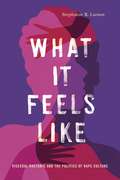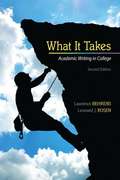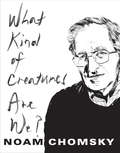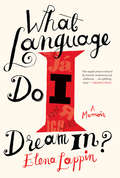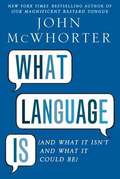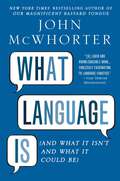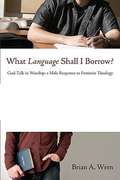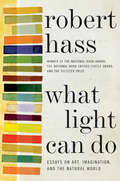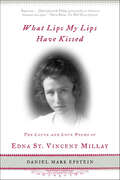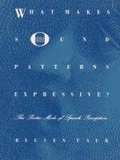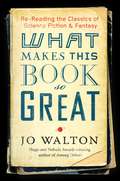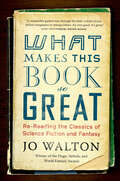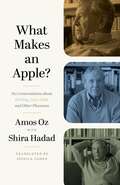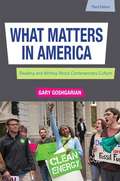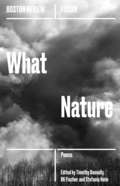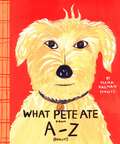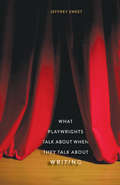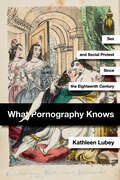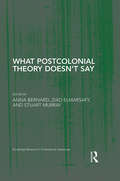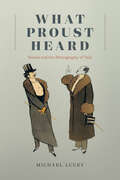- Table View
- List View
What It Feels Like: Visceral Rhetoric and the Politics of Rape Culture (Rhetoric and Democratic Deliberation #27)
by Stephanie R. LarsonWhat It Feels Like interrogates an underexamined reason for our failure to abolish rape in the United States: the way we communicate about it. Using affective and feminist materialist approaches to rhetorical criticism, Stephanie Larson examines how discourses about rape and sexual assault rely on strategies of containment, denying the felt experiences of victims and ultimately stalling broader claims for justice.Investigating anti-pornography debates from the 1980s, Violence Against Women Act advocacy materials, sexual assault forensic kits, public performances, and the #MeToo movement, Larson reveals how our language privileges male perspectives and, more deeply, how it is shaped by systems of power—patriarchy, white supremacy, and heteronormativity as well as masculine commitments to "science" or "evidence." In addition, Larson finds that the culture holds a general mistrust of testimony by women, stereotyping it as "emotional." But she also gives us hope for change, arguing that women’s testimony—the bodily, material expression of violation—is needed to give voice to victims of sexual violence and to present, accurately, the facts of these crimes. Larson makes a case for visceral rhetorics, theorizing them as powerful forms of communication and persuasion.Demonstrating the communicative power of bodily feeling, Larson challenges the long-held commitment to detached, distant, rationalized discourses of sexual harassment and rape. Timely and poignant, the book offers a much-needed corrective to our legal and political discourses.
What It Feels Like: Visceral Rhetoric and the Politics of Rape Culture (Rhetoric and Democratic Deliberation)
by Stephanie R. LarsonWinner of the 2022 Association for the Rhetoric of Science, Technology, and Medicine (ARSTM) Book AwardWinner of the 2022 Winifred Bryan Horner Outstanding Book Award from the Coalition of Feminist Scholars in the History of Rhetoric and CompositionWhat It Feels Like interrogates an underexamined reason for our failure to abolish rape in the United States: the way we communicate about it. Using affective and feminist materialist approaches to rhetorical criticism, Stephanie Larson examines how discourses about rape and sexual assault rely on strategies of containment, denying the felt experiences of victims and ultimately stalling broader claims for justice.Investigating anti-pornography debates from the 1980s, Violence Against Women Act advocacy materials, sexual assault forensic kits, public performances, and the #MeToo movement, Larson reveals how our language privileges male perspectives and, more deeply, how it is shaped by systems of power—patriarchy, white supremacy, ableism, and heteronormativity. Interrogating how these systems work to propagate masculine commitments to “science” and “hard evidence,” Larson finds that US culture holds a general mistrust of testimony by women, stereotyping it as “emotional.” But she also gives us hope for change, arguing that testimonies grounded in the bodily, material expression of violation are necessary for giving voice to victims of sexual violence and presenting, accurately, the scale of these crimes. Larson makes a case for visceral rhetorics, theorizing them as powerful forms of communication and persuasion.Demonstrating the communicative power of bodily feeling, Larson challenges the long-held commitment to detached, distant, rationalized discourses of sexual harassment and rape. Timely and poignant, the book offers a much-needed corrective to our legal and political discourses.
What It Takes: Academic Writing in College
by Laurence Behrens Leonard J. RosenWhat It Takes: Academic Writing in College prepares the reader for the most common college writing assignments: the summary, the critique, the synthesis, and the analysis.
What Kind of Creatures Are We? (Columbia Themes in Philosophy)
by Noam ChomskyThe renowned philosopher and political theorist presents a summation of his influential work in this series of Columbia University lectures. A pioneer in the fields of modern linguistics and cognitive science, Noam Chomsky is also one of the most avidly read political theorist of our time. In this series of lectures, Chomsky presents more than half a century of philosophical reflection on all three of these areas. In precise yet accessible language, Chomsky elaborates on the scientific study of language, sketching how his own work has implications for the origins of language, the close relations that language bears to thought, its eventual biological basis. He expounds and criticizes many alternative theories, such as those that emphasize the social, the communicative, and the referential aspects of language. He also investigates the apparent scope and limits of human cognitive capacities. Moving from language and mind to society and politics, Chomsky concludes with a philosophical defense of a position he describes as "libertarian socialism," tracing its links to anarchism and the ideas of John Dewey, and even briefly to the ideas of Karl Marx and John Stuart Mill. Demonstrating its conceptual growth out of our historical past, he also shows its urgent relation to our present moment.
What Language Do I Dream In?: A Memoir
by Elena LappinTaking its title from a question often asked of polyglots, What Language Do I Dream In? is Elena Lappin's stunning memoir about how language runs throughout memory and family history to form identity. Lappin's life could be described as "five languages in search of an author", and as a multiple émigré, her decision to write in English was the result of many wanderings. Russian, Czech, German, Hebrew, and finally, English: each language is a link to a different piece of Lappin's rich family mosaic and the struggle to find a voice in a language not one's own.From Europe to North America—and back again, via some of the twentieth century's most significant political upheavals—Lappin reconstructs the stories and secrets of her parents and grandparents with the tenderness of a novelist and the eye of a documentary filmmaker. The story of Lappin's identity is unexpectedly complicated by the discovery, in middle age, that her biological father was an American living in Russia. This revelation makes her question the very bedrock of her knowledge of her birth, and adds a surprising twist: suddenly, English may be more than the accidental "home in exile"—it is a language she may have been close to from the very beginning."English is not my mother tongue," writes Elena Lappin, "it is something more valuable: a language I was lucky enough to be able to choose." What Language Do I Dream In? is a wonderful, honest story about love, family, memory, and how they intertwine to form who we are.
What Language Is (and What It Isn't and What It Could Be)
by John McwhorterNew York Times bestselling author and renowned linguist, John McWhorter, explores the complicated and fascinating world of languages. From Standard English to Black English; obscure tongues only spoken by a few thousand people in the world to the big ones like Mandarin - What Language Is celebrates the history and curiosities of languages around the world and smashes our assumptions about "correct" grammar. An eye-opening tour for all language lovers, What Language Is offers a fascinating new perspective on the way humans communicate. From vanishing languages spoken by a few hundred people to major tongues like Chinese, with copious revelations about the hodgepodge nature of English, John McWhorter shows readers how to see and hear languages as a linguist does. Packed with Big Ideas about language alongside wonderful trivia, What Language Is explains how languages across the globe (the Queen's English and Surinam creoles alike) originate, evolve, multiply, and divide. Raising provocative questions about what qualifies as a language (so-called slang does have structured grammar), McWhorter also takes readers on a marvelous journey through time and place-from Persian to the languages of Sri Lanka- to deliver a feast of facts about the wonders of human linguistic expression.
What Language Is: And What It Isn't and What It Could Be
by John McWhorterNew York Times bestselling author and renowned linguist, John McWhorter, explores the complicated and fascinating world of languages. From Standard English to Black English; obscure tongues only spoken by a few thousand people in the world to the big ones like Mandarin - What Language Is celebrates the history and curiosities of languages around the world and smashes our assumptions about "correct" grammar. An eye-opening tour for all language lovers, What Language Is offers a fascinating new perspective on the way humans communicate. From vanishing languages spoken by a few hundred people to major tongues like Chinese, with copious revelations about the hodgepodge nature of English, John McWhorter shows readers how to see and hear languages as a linguist does. Packed with Big Ideas about language alongside wonderful trivia, What Language Is explains how languages across the globe (the Queen's English and Surinam creoles alike) originate, evolve, multiply, and divide. Raising provocative questions about what qualifies as a language (so-called slang does have structured grammar), McWhorter also takes readers on a marvelous journey through time and place-from Persian to the languages of Sri Lanka- to deliver a feast of facts about the wonders of human linguistic expression.
What Language Shall I Borrow?: A Male Response to Feminist Theology
by Brian A. WrenThe author of this book writes from the experience of being English, white, male, and heterosexual, and as one who values the Reformed tradition and has been shaped and enriched by it.
What Light Can Do: Essays on Art, Imagination, and the Natural World
by Robert HassUniversally lauded poet Robert Hass offers a stunning, wide-ranging collection of essays on art, imagination, and the natural world—with accompanying photos throughout. What Light Can Do is a magnificent companion piece to the former U.S. Poet Laureate’s Pulitzer Prize and National Book Award-winning poetry collection, Time and Materials, as well as his earlier book of essays, the NBCC Award-winner Twentieth Century Pleasures. Haas brilliantly discourses on many of his favorite topics—on writers ranging from Jack London to Wallace Stevens to Allen Ginsberg to Cormac McCarthy; on California; and on the art of photography in several memorable pieces—in What Light Can Do, a remarkable literary treasure that might best be described as “luminous.”
What Lips My Lips Have Kissed: The Loves and Love Poems of Edna St. Vincent Millay
by Daniel Mark EpsteinA noted biographer and poet illuminates the unique woman who wrote the greatest American love poetry of the twentieth centuryWhat Lips My Lips Have Kissed is the story of a rare sort of American genius, who grew up in grinding poverty in Camden, Maine. Nothing could save the sensitive child but her talent for words, music and drama, and an inexorable desire to be loved. When she was twenty, her poetry would make her famous; at thirty she would be loved by readers the world over.Edna St. Vincent Millay was widely considered to be the most seductive woman of her age. Few men could resist her, and many women also fell under her spell. From the publication of her first poems until the scandal over Fatal Interview twenty years later, gossip about the poet's liberated lifestyle prompted speculation about who might be the real subject of her verses.Using letters, diaries and journals of the poet and her lovers that have only recently become available, Daniel Mark Epstein tells the astonishing story of the life, dedicated to art and love, that inspired the sublime lyrics of Edna St. Vincent Millay.
What Literature Teaches Us about Emotion
by Patrick Colm Hogan"Literature provides us with otherwise unavailable insights into the ways emotions are produced, experienced and enacted in human social life. It is particularly valuable because it deepens our comprehension of the mutual relations between emotional response and ethical judgment. These are the central claims of Hogan's study, which carefully examines a range of highly esteemed literary works in the context of current neurobiological, psychological, sociological and other empirical research. In this work, he explains the value of literary study for a cognitive science of emotion and outlines the emotional organization of the human mind. He explores the emotions of romantic love, grief, mirth, guilt, shame, jealousy, attachment, compassion and pity - in each case drawing on one work by Shakespeare and one or more works by writers from different historical periods or different cultural backgrounds, such as the eleventh-century Chinese poet Li Ch'ing-Chao and the contemporary Nigerian playwright Wole Soyinka"--
What Logics Mean
by James W. GarsonWhat do the rules of logic say about the meanings of the symbols they govern? In this book, James W. Garson examines the inferential behaviour of logical connectives (such as 'and', 'or', 'not' and 'if . . . then'), whose behaviour is defined by strict rules, and proves definitive results concerning exactly what those rules express about connective truth conditions. He explores the ways in which, depending on circumstances, a system of rules may provide no interpretation of a connective at all, or the interpretation we ordinarily expect for it, or an unfamiliar or novel interpretation. He also shows how the novel interpretations thus generated may be used to help analyse philosophical problems such as vagueness and the open future. His book will be valuable for graduates and specialists in logic, philosophy of logic, and philosophy of language.
What Makes Living Things Go? (SEEDS Book Reader)
by Jonathan Curley Kevin BealsNIMAC-sourced textbook
What Makes Sound Patterns Expressive?: The Poetic Mode of Speech Perception
by Reuven TsurPoets, academics, and those who simply speak a language are subject to mysterious intuitions about the perceptual qualities and emotional symbolism of the sounds of speech. Such intuitions are Reuven Tsur's point of departure in this investigation into the expressive effect of sound patterns, addressing questions of great concern for literary theorists and critics as well as for linguists and psychologists.Research in recent decades has established two distinct types of aural perception: a nonspeech mode, in which the acoustic signals are received in the manner of musical sounds or natural noises; and a speech mode, in which acoustic signals are excluded from awareness and only an abstract phonetic category is perceived. Here, Tsur proposes a third type of speech perception, a poetic mode in which some part of the acoustic signal becomes accessible, however faintly, to consciousness.Using Roman Jakobson's model of childhood acquisition of the phonological system, Tsur shows how the nonreferential babbling sounds made by infants form a basis for aesthetic valuation of language. He tests the intersubjective and intercultural validity of various spatial and tactile metaphors for certain sounds. Illustrating his insights with reference to particular literary texts, Tsur considers the relative merits of cognitive and psychoanalytic approaches to the emotional symbolism of speech sounds.
What Makes This Book So Great: Re-Reading the Classics of Fantasy and SF
by Jo WaltonJo Walton is an award-winning author of, inveterate reader of, and chronic re-reader of science fiction and fantasy books. What Makes This Book So Great? is a selection of the best of her musings about her prodigious reading habit. Jo Walton’s many subjects range from acknowledged classics, to guilty pleasures, to forgotten oddities and gems. Among them, the Zones of Thought novels of Vernor Vinge; the question of what genre readers mean by ‘mainstream’; the under-appreciated SF adventures of C. J. Cherryh; the field’s many approaches to time travel; the masterful science fiction of Samuel R. Delany; Salman Rushdie’s Midnight’s Children; the early Hainish novels of Ursula K. Le Guin; and a Robert A. Heinlein novel you have most certainly never read. Over 130 essays in all, What Makes This Book So Great is an immensely engaging collection of provocative, opinionated thoughts about past and present-day fantasy and science fiction, from one of our best writers.
What Makes This Book So Great: Re-Reading the Classics of Science Fiction and Fantasy
by Jo Walton“A remarkable guided tour through the field—a kind of nonfiction companion to Among Others. It’s very good. It’s great.” —Cory Doctorow, Boing BoingAs any reader of Jo Walton’s Among Others might guess, Walton is both an inveterate reader of SF and fantasy, and a chronic re-reader of books. In 2008, then-new science-fiction mega-site Tor.com asked Walton to blog regularly about her re-reading—about all kinds of older fantasy and SF, ranging from acknowledged classics, to guilty pleasures, to forgotten oddities and gems. These posts have consistently been among the most popular features of Tor.com. Now this volumes presents a selection of the best of them, ranging from short essays to long reassessments of some of the field’s most ambitious series.Among Walton’s many subjects here are the Zones of Thought novels of Vernor Vinge; the question of what genre readers mean by “mainstream”; the underappreciated SF adventures of C. J. Cherryh; the field’s many approaches to time travel; the masterful science fiction of Samuel R. Delany; Salman Rushdie’s Midnight’s Children; the early Hainish novels of Ursula K. Le Guin; and a Robert A. Heinlein novel you have most certainly never read.Over 130 essays in all, What Makes This Book So Great is an immensely readable, engaging collection of provocative, opinionated thoughts about past and present-day fantasy and science fiction, from one of our best writers.“For readers unschooled in the history of SF/F, this book is a treasure trove.” —Publishers Weekly (starred review)
What Makes an Apple?: Six Conversations about Writing, Love, Guilt, and Other Pleasures
by Amos OzRevelatory talks about art and life with internationally acclaimed Israeli novelist Amos OzIn the last years of his life, the writer Amos Oz talked regularly with Shira Hadad, who worked closely with him as the editor of his final novel, Judas. These candid, uninhibited dialogues show a side of Oz that few ever saw. What Makes an Apple? presents the most revealing of these conversations in English for the first time, painting an illuminating and disarmingly intimate portrait of a towering literary figure.In frank and open exchanges that are by turns buoyant, introspective, and argumentative, Oz explains what impels him to begin a story and shares his routines, habits, and challenges as a writer. He discusses the tectonic changes he experienced in his lifetime in relationships between women and men, and describes how his erotic coming of age shaped him not only as a man but also as an author. Oz reflects on his parents, his formative years on a kibbutz, and how he dealt with and learned from his critics, his students, and his fame. He talks about why there is more humor in his later books and gives his exceptional take on fear of death.Resonating with Oz’s clear, honest, and humorous voice, What Makes an Apple? offers unique insights about Oz’s artistic and personal evolution, and enables readers to explore his work in new ways.
What Matters in America
by Gary J. GoshgarianCompact in both page count and trim size,What Matters in America's themes examine popular culture topics and provide a sufficient number of selections to make sure topics are given with adequate depth. Gary Goshgarian addresses topics of: Television Violence, Racial Profiling, Capital Punishment and Gay Marriage.
What Nature (Boston Review)
by Timothy Donnelly B. Fischer Stefania HeimPoetry that grapples with the intersection of natural and cultural crises. In an age of record-breaking superstorms and environmental degradation, What Nature seeks—through poetry—to make sense of how we interact with and are influenced by nature. Shifting its focus from what has already been lost to what lies ahead, What Nature rejects the sentimentality of traditional nature poetry. Instead, its texts expose and resist the global iniquities that create large-scale human suffering, a world where climate change disproportionately affects the poorest communities. The intersection of natural and cultural crises—like Standing Rock's fight against the Dakota Access Pipeline and the water crisis in Flint, Michigan—are confronted head on. These poems, lyric essays, and hybrid works grapple with political unrest, refugeeism, and resource exploitation, transforming the genre of ecopoetics. Contributors Kaveh Akbar, Zaina Alsous, Desirée Alvarez, Rae Armantrout, Aase Berg, Kyle Booten, Jericho Brown, Kyce Bello, Kayleb Rae Candrilli, Jesús Castillo,, Abigail Chabitnoy,Adam Day, Camille T. Dungy, Noah Dversdall, Gyrðir Elíasson, Tracy Fuad, Carolyn Guinzio, Amanda Hawkins, Sheikha Helawy, Claire Hero, Brenda Hillman, Joan Kane, Douglas Kearney, Benjamín Naka-Hasebe Kingsley, Nam Le, Diana Keren Lee, Adrian Lurssen, Matt Massaia, Iréne Mathieu, Ted Mathys, Christopher Nelson, Kathy Nilsson, Greg Nissan, Elsbeth Pancrazi, Sarah Passino, Rowan Ricardo Phillips, Roger Reeves, Evelyn Reilly, Emelia Reuterfors, Mutsuo Takahashi, Brian Tierney, Alissa Valles, Nicole Walker, Ellen Welcker
What Pete Ate from A to Z
by Maira KalmanIs there anything Pete won't eat? Poppy Wise's sweet but unruly dog starts with Nico's accordion and works his way through the alphabet, making a nuisance of himself by leaving nothing untouched, not even glue sticks or Uncle Norman's underpants. Despite Pete's ravenous ways, a frazzled Poppy Wise can't help loving him. Kids will laugh at Pete's impossible cuisine, adults will appreciate the offbeat sense of humor, and both will love the artwork that perfectly captures the fun of the text in this unique alphabet book only Maira Kalman could create.
What Playwrights Talk About When They Talk About Writing
by Jeffrey SweetThe art and craft of playwriting as explored in candid conversations with some of the most important contemporary dramatists Edward Albee, Lanford Wilson, Lynn Nottage, A. R. Gurney, and a host of other major creative voices of the theater discuss the art of playwriting, from inspiration to production, in a volume that marks the tenth anniversary of the Yale Drama Series and the David Charles Horn Foundation Prize for emerging playwrights. Jeffrey Sweet, himself an award-winning dramatist, hosts a virtual roundtable of perspectives on how to tell stories onstage featuring extensive interviews with a gallery of gifted contemporary dramatists. In their own words, Arthur Kopit, Marsha Norman, Christopher Durang, David Hare, and many others offer insights into all aspects of the creative writing process as well as their personal views on the business, politics, and fraternity of professional theater. This essential work will give playwrights and playgoers alike a deeper and more profound appreciation of the art form they love.
What Pornography Knows: Sex and Social Protest since the Eighteenth Century
by Kathleen LubeyWhat Pornography Knows offers a new history of pornography based on forgotten bawdy fiction of the eighteenth century, its nineteenth-century republication, and its appearance in 1960s paperbacks. Through close textual study, Lubey shows how these texts were edited across time to become what we think pornography is—a genre focused primarily on sex. Originally, they were far more variable, joining speculative philosophy and feminist theory to sexual description. Lubey's readings show that pornography always had a social consciousness—that it knew, long before anti-pornography feminists said it, that women and nonbinary people are disadvantaged by a society that grants sexual privilege to men. Rather than glorify this inequity, Lubey argues, the genre's central task has historically been to expose its artifice and envision social reform. Centering women's bodies, pornography refuses to divert its focus from genital action, forcing readers to connect sex with its social outcomes. At times inventing their own sexual anatomy and gender identity, at times having their bodies claimed and used by others, pornographic figures bring genitals to the fore, insisting they be justly treated rather than coldly transacted. Lubey offers a surprising take on a deeply misunderstood cultural form: pornography transforms sexual description into feminist commentary, she argues, revealing the genre's deep knowledge of how social inequities are perpetuated as well as plans for how to rectify them.
What Postcolonial Theory Doesn't Say (Routledge Research in Postcolonial Literatures)
by Stuart Murray Ziad Elmarsafy Anna BernardThis book reclaims postcolonial theory, addressing persistent limitations in the geographical, disciplinary, and methodological assumptions of its dominant formations. It emerges, however, from an investment in the future of postcolonial studies and a commitment to its basic premise: namely, that literature and culture are fundamental to the response to structures of colonial and imperial domination. To a certain extent, postcolonial theory is a victim of its own success, not least because of the institutionalization of the insights that it has enabled. Now that these insights no longer seem new, it is hard to know what the field should address beyond its general commitments. Yet the renewal of popular anti-imperial energies across the globe provides an important opportunity to reassert the political and theoretical value of the postcolonial as a comparative, interdisciplinary, and oppositional paradigm. This collection makes a claim for what postcolonial theory can say through the work of scholars articulating what it still cannot or will not say. It explores ideas that a more aesthetically sophisticated postcolonial theory might be able to address, focusing on questions of visibility, performance, and literariness. Contributors highlight some of the shortcomings of current postcolonial theory in relation to contemporary political developments such as Zimbabwean land reform, postcommunism, and the economic rise of Asia. Finally, they address the disciplinary, geographical, and methodological exclusions from postcolonial studies through a detailed focus on new disciplinary directions (management studies, international relations, disaster studies), overlooked locations and perspectives (Palestine, Weimar Germany, the commons), and the necessity of materialist analysis for understanding both the contemporary world and world literary systems.
What Proust Heard: Novels and the Ethnography of Talk
by Michael LuceyMichael Lucey offers a linguistic anthropological analysis of Proust’s In Search of Lost Time. What happens when we talk? This deceptively simple question is central to Marcel Proust’s monumental novel In Search of Lost Time. Both Proust’s narrator and the novel that houses him devote considerable energy to investigating not just what people are saying or doing when they talk, but also what happens socioculturally through their use of language. Proust, in other words, is interested in what linguistic anthropologists call language-in-use. Michael Lucey elucidates Proust’s approach to language-in-use in a number of ways: principally in relation to linguistic anthropology, but also in relation to speech act theory, and to Pierre Bourdieu’s sociology. The book also includes an interlude after each of its chapters that contextualizes Proust’s social-scientific practice of novel writing in relation to that of a number of other novelists, earlier and later, and from several different traditions, including Honoré de Balzac, George Eliot, Virginia Woolf, Nathalie Sarraute, and Rachel Cusk. Lucey is thus able to show how, in the hands of quite different novelists, various aspects of the novel form become instruments of linguistic anthropological analysis. The result introduces a different way of understanding language to literary and cultural critics and explores the consequences of this new understanding for the practice of literary criticism more generally.
